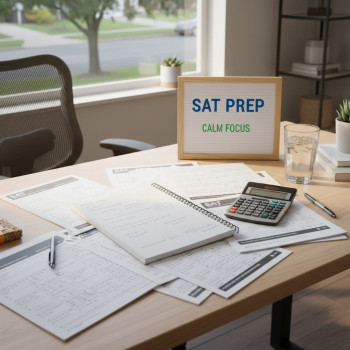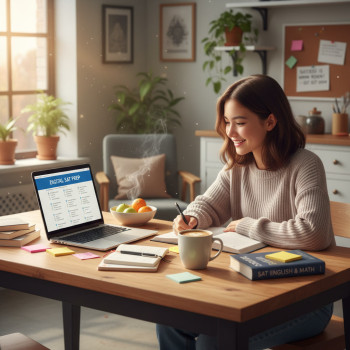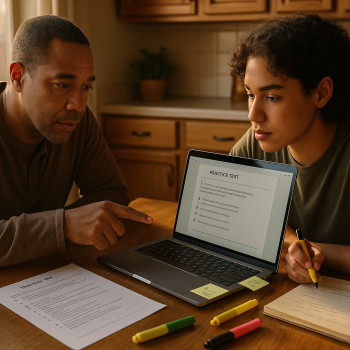Why Parents Matter: Calm Confidence Before the Digital SAT
There’s something quietly powerful about a parent who knows the test-day playbook. You don’t have to be a subject expert to make a huge difference—just informed, calm, and prepared. The Digital SAT has changed some of the logistics compared with the old paper test: devices, apps, and a shorter testing window. But the human side of the experience—arriving on time, following rules, and helping your teen manage nerves—still matters more than ever.

What’s changed (and what hasn’t)
In short: the format is digital, but the expectations around integrity, respect for the test environment, and practical readiness remain unchanged. Test centers follow strict procedures to protect the fairness and security of the exam. As a parent, your role is to understand those procedures, help your student prepare their device and materials, and support good etiquette so their scores are safe.
Before Test Day: Logistics and Preparation
Start early. Little things that get fixed the night before—charging a device, printing an admission ticket, laying out a comfy but rule-compliant outfit—save big stress on the morning of the test. Here’s a practical checklist you can use with your student.
Essential checklist for parents (48–72 hours ahead)
- Confirm test time and location on the student’s Bluebook admission ticket and the test center website. Note the door time—centers often open early and close promptly.
- Ensure the testing device is compatible, fully updated, and has the Bluebook app installed. Complete the exam setup in Bluebook 1–5 days before the test so the admission ticket is generated.
- Practice arriving at the test center if it’s unfamiliar. Time a dry run for commute, parking, and entry procedures.
- Check ID requirements: your student must bring a physical acceptable photo ID if testing away from their regular school. Know what IDs are accepted and bring a printed admission ticket (preferred) or an accessible digital copy.
- Discuss permitted items and what must stay home (phones, smartwatches, earbuds, paper of any kind, detachable privacy screens, etc.).
- Plan food/drink for breaks if allowed; many centers permit a snack and drink stored under the desk during the test break.
- If your student has accommodations, confirm approval and that the test coordinator and proctors know the details.
Device prep—simple steps to avoid tech drama
The Digital SAT requires your student’s device to run Bluebook smoothly. This can sound intimidating, but think of it like prepping a laptop for an important online assignment.
- Fully charge the device and bring a charger or portable battery—outlets are not guaranteed in the testing room.
- Install Bluebook and complete exam setup well before test day. The app will check your device, download the test bundle, and create the admission ticket.
- Close all other apps, disable notifications, and remove any peripheral devices not allowed (some external keyboards are allowed only for certain tablet setups; check requirements ahead of time).
- Bring an external mouse if your student prefers one; an external keyboard is allowed in specific circumstances (e.g., tablets). Do not bring detachable privacy screens.
- Bring a backup device if possible and allowed by the center—ask the coordinator in advance about policies for switching devices if needed.
What to Bring—and What to Leave at Home
Knowing exactly what’s permitted avoids last-minute surprises and the risk of dismissal. Think of the test center as a protected workspace: only the tools approved for testing are allowed.
Must-haves
- Fully charged testing device with Bluebook installed and exam setup complete.
- Printed admission ticket (preferred) or clear access to the admission ticket generated by Bluebook.
- Acceptable physical photo ID if required (bring the original, not a photo on a phone).
- Pen or pencil for scratch work (scratch paper will be provided and collected by proctors).
- Any approved medical devices or medications (EpiPens can be on hand; label and store them as the center instructs).
Nice-to-haves (if the center allows)
- Charging cable or portable charger (store it as instructed).
- Watch without an audible alarm—Bluebook includes a timer, but some students like a personal watch for break timing.
- Snack and water for the break (stored under the desk during testing).
- Comfortable layered clothing—hoodies are usually okay but hoods should be down.
Leave these at home
- Cell phones, smartwatches, earbuds, fitness trackers, or other electronic devices not approved for testing. If these items are seen or used, the student may be dismissed and their scores canceled.
- Papers of any kind, books, notes, highlighters, references, or calculators not allowed by the test rules.
- Detachable privacy screens, brimmed hats that obscure the face (hats that are allowed typically must be removed or stored under the desk), and any devices that could record audio or video.
Test Center Etiquette: The Human Rules That Keep Things Fair
Etiquette is less about being formal and more about creating a reliable, distraction-free environment for everyone. Students who follow these guidelines avoid embarrassment and protect their scores.
Arrival and check-in
- Arrive early—test centers often open before the stated seating time. Doors usually close promptly; late arrivals may not be admitted.
- Bring the printed admission ticket and ID to check in. If your student is testing at their home school, rules may be slightly different, but ID and admission confirmation are typical requirements when testing away from the regular school.
- Expect identity verification and seating instructions. The proctor will give instructions about storing prohibited items and where to place backpacks and personal belongings.
During the test
- Follow proctors’ instructions. If a student has a question, they should raise their hand and wait for assistance—walking out of the room or speaking loudly can disrupt others.
- No talking, gesturing, or communicating with other test takers. Even subtle signals can be considered misconduct and may lead to score cancellation.
- Keep the testing area tidy. Scratch paper is collected at the end of the session; personal items should be stored where proctors instruct.
- Use only the tools allowed by Bluebook or approved accommodations. Attempting to use unauthorized aids is a serious violation.
Breaks and what to do with prohibited items
Breaks are a natural part of the Digital SAT experience. Proctors will tell students when it’s time for a break and how long they have. During breaks, prohibited devices must remain stored as instructed—students cannot access phones or smartwatches. Returning early or accessing contraband during a break can lead to dismissal.
Common Concerns and Real-World Scenarios
Parents often worry about unusual scenarios. Here are common questions with practical guidance so you can prepare a calm plan B.
What if the device fails during the test?
Devices can be temperamental. The Bluebook app and test centers are set up to allow switching devices if needed. If your student’s device fails mid-test, the proctor or tech coordinator will assist. Remind your student to keep calm—answers are periodically saved and can be recovered or re-entered on a replacement device in most cases.
What happens if my child is late?
Test centers usually close their doors at a specific time and cannot admit students after testing begins. If your student is late, they may have to register for another date and pay the standard fee again. That’s why planning commute time and arriving early are essential.
What about accommodations and medical needs?
If your student has approved accommodations—such as extended time, a separate room, or assistive technologies—confirm details with the test coordinator before test day. For medical devices or medications, bring them in accordance with test center instructions (EpiPens, for example, must be in a clear bag and stored under the desk).
How Parents Can Coach Test-Day Behavior (Without Doing the Test for Them)
Modeling calm and providing practical coaching can boost performance. Here are phrases and actions that help more than pressure.
Simple, effective coaching cues
- “Arrive early so you can breathe before the test.”
- “If anything goes wrong with your device, raise your hand and don’t panic—proctors will help.”
- “Keep your phone in your bag or car. If it’s visible, it could cause a problem.”
- “Use the timer in Bluebook and trust your pacing plan—move on if you’re stuck and come back if time permits.”
Practice runs that build confidence
Do a mock check-in at home: install Bluebook, complete exam setup, print or screenshot the admission ticket, and simulate the arrival routine. If your student works with a tutor—Sparkl’s personalized tutoring, for example, often includes 1-on-1 guidance and tailored study plans that can integrate realistic test-day simulations—incorporate a timed practice using the same device so the actual day feels familiar.
Table: Quick Reference for Parents—Allowed vs. Prohibited Items
| Category | Allowed | Prohibited |
|---|---|---|
| Testing Device | Student’s laptop/tablet/Chromebook with Bluebook installed; school-managed devices if permitted | Unapproved devices without Bluebook or devices that haven’t completed exam setup |
| Personal Electronics | Chargers stored as instructed; hearing aids or approved assistive tech | Cell phones, smartwatches, earbuds, fitness trackers, recording devices |
| Writing Materials | Pens/pencils for scratch work; scratch paper provided and collected by proctors | Books, notes, reference sheets, extra papers |
| Comfort | Hoodies with hoods down, plain watches without alarms | Brimmed caps that obscure the face, clothing with hidden notes |
| Medications | Allowed if stored/declared per center rules; EpiPens in clear bag under desk | Unlabeled medications or items not disclosed to proctors |
After the Test: What Parents Should Know
Once testing ends, proctors will collect scratch paper and dismiss students quietly. Scores for the Digital SAT are typically reported through the College Board channels—make sure your student knows how their score report will be delivered and how to link scores to colleges if they haven’t already done so during registration.
Debrief with purpose
- Ask open questions: “What felt manageable? What surprised you?” Avoid grilling about each question—focus on attitude, pacing, and comfort level.
- Plan next steps. If your student wants to improve a particular section, consider additional targeted practice. Tailored tutoring, such as Sparkl’s personalized sessions, can help pinpoint weak areas and build a customized plan that fits the student’s schedule and learning style.
- Celebrate the effort. Test days are demanding—recognize the discipline it took to get through the exam.
Real-Life Example: A Calm Test-Day Recovery
Consider Maya, a high school senior who discovered a day-before glitch: her tablet wouldn’t run Bluebook after an OS update. Her parent calmly called the test center the evening before, and they confirmed a school-managed Chromebook would be available. The parent packed a backup charger and drove Maya to the center early. During check-in, Maya completed the setup on the Chromebook, tested the built-in calculator, and felt reassured. Midway through the test, Maya experienced a brief internet hiccup—the device preserved her answers, and proctors coached her through switching to airplane mode and continuing without disruption. She finished confidently. The keys to this smooth outcome were preparation, remaining calm, and knowing the center’s procedures.
Final Tips: Small Habits That Make a Big Difference
- Run through your checklist together the night before—packing, charging, printing, and ID checks reduce morning friction.
- Encourage light, familiar breakfast choices the morning of the test; heavy or unfamiliar foods can cause discomfort.
- Remind your student to use the universal Bluebook tools (timer, mark-for-review, calculator) in practice sessions so they’re second nature on test day.
- Keep conversations focused and positive; practical reminders beat anxiety-inducing lectures.
How Sparkl’s Personalized Tutoring Can Fit In
Many families find that beyond content review, the confidence that comes from personalized test-day rehearsals is invaluable. Personalized tutoring—like the 1-on-1 guidance available through Sparkl—can simulate Bluebook usage, build pacing strategies, and create tailored study plans. Tutors can conduct realistic, timed digital practice sessions on the student’s own device and include coaching on test center etiquette so the real test day feels familiar rather than foreign.
Parting Thoughts for Parents
As a parent, your job is not to fix every problem but to reduce avoidable ones. Learn the rules, rehearse the logistics, and cultivate calm. The Digital SAT may look different on the surface, but the path to success is the same: solid preparation, thoughtful pacing, and the right support. When you combine this with targeted practice and, if needed, personalized tutoring, your student is well positioned to walk into the test center ready to do their best.

Keep communication open, prioritize rest and nutrition, and remember: one test is a data point, not the whole story. With your help and the right preparation, your student will get through the Digital SAT with competence and calm.















No Comments
Leave a comment Cancel